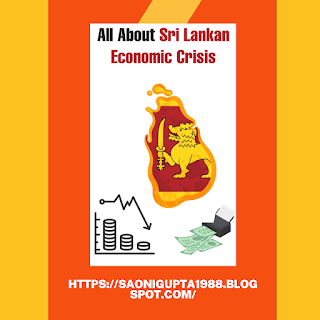From Prosperity to Bankruptcy: Sri Lanka's Tragic Tale
The year 2022 has been a tough one for Sri Lanka, as the country has declared bankruptcy. In 2022, Sri Lanka became the first country in the world to declare bankruptcy. The Sri Lankan government has been unable to make payments on its debt and has been forced to declare a state of financial emergency and bankruptcy. This was a devastating blow to the Sri Lankan economy and led to widespread poverty and economic hardship. This has come as a shock to many and has caused much upheaval and confusion in the nation. In a time of such uncertainty, it is important to understand the events that led up to this bankruptcy and consider how it could have been avoided. This blog will explore the reasons behind Sri Lanka's impending bankruptcy as well as the consequences of this event.
Introduction
According to the government-owned Ceylon Economic News, Sri Lanka declared bankruptcy in 2022. This was the first time a country in South Asia has gone bankrupt. Sri Lanka's economic woes are largely due to the country's heavy reliance on debt financing. The bankruptcy of Sri Lanka was a major blow to the region, which has already been struggling with high levels of debt. This has been a difficult time for the citizens of Sri Lanka, as the country’s economy has been crippled by this sudden and unexpected financial blow. By understanding the underlying causes of the bankruptcy, we can gain a better understanding of how to prevent such a crisis in the future.
Causes of Sri Lanka's Bankruptcy
In 2022, Sri Lanka declared bankruptcy due to a combination of factors. The country became bankrupt due to an influx of debt and the government's inability to pay back creditors. This came after several years of economic decline and political instability, which resulted in a large budget deficit and the accumulation of external debt.
The country came to a state of financial bankruptcy and struggled to pay its debts, with an estimated debt of over $50 billion, or, to be precise, $64.9 billion. The country is expected to default on its loans in the next four years. The country’s currency has also depreciated significantly, causing inflation to rise and the cost of living to increase.
Additionally, many nations owned Sri Lanka's national debt, but China, India, and Japan stood out as the biggest holders. About 10% of Sri Lanka's debt is held by China, which has frequently been cited as an example of "debt trap diplomacy."
The truth is more complex; China, in fact, refused to cancel any of Sri Lanka's debt during the financial crisis of 2022, and the bilateral debt structure included ambiguous terms and little relief. Additionally, if you include debt owned by Chinese banks like the China Development Bank and the EXIM Bank of China, the amount of debt held by Chinese entities was closer to 26%.
Moreover, the International Monetary Fund (IMF) has warned Sri Lanka that it must take steps to reduce its debt burden, including increasing revenue and cutting spending. However, the government has been reluctant to make these changes, fearing that they will lead to social unrest.
Due to this financial crisis, Sri Lanka had to turn to the IMF and other international organizations for assistance. This led the government to implement a series of austerity measures and economic restructuring, including the devaluation of the Sri Lankan rupee, cuts to public wages, and an increase in taxes. Unfortunately, these measures have been largely unsuccessful, and the country has started to face a severe economic crisis.
Sri Lankan Government's Role
When the civil war came to an end in 2009, the then-president Mahinda Rajapaksa borrowed heavily from international lenders to cover war costs and, more crucially, to launch extravagant infrastructure projects that would draw tourists and reward supporters.
In a vicious process, the government's limited foreign reserves forced it to rely on foreign lenders, like the Chinese, to assist cover its existing debt. Instead of concentrating on economic changes that may boost those reserves, the Rajapaksas adopted a number of tax reductions to boost political support.
Moreover, Sri Lanka's main source of foreign income, tourism, was severely damaged by the 2019 Easter bombings and the 2020 COVID-19 pandemic. To make matters worse, in 2021, then-President Gotabaya Rajapaksa made the disastrous decision to prohibit artificial fertilizers in order to convert Sri Lankan agriculture to organic farming, which completely destroyed Sri Lanka's largest export industry, the tea industry.
The country's food insecurity has increased as a result of the fertilizer restriction, which was eventually removed, and worldwide grain shortages caused by the conflict in Ukraine. A once-vibrant and economically promising South Asian country collapsed as a result of the Rajapaksa administration's economic strategy, which turned out to be a succession of errors and false bravado.
The economic crisis was unsolvable by mid-July, and despite being generally peaceful, the demonstrators had destroyed the Prime Minister's home and taken over the presidential palace. As things heated up, Gotabaya at last promised to step down by July 13, 2022. After months of growing unrest and his brother Mahinda Rajapaksa's resignation as Prime Minister in May 2022, Sri Lankan President Gotabaya Rajapaksa left the country on July 13, 2022, without resigning.
As a result of Gotabaya's departure, the government is even more in chaos. On July 15, 2022, Wikremensinghe was formally sworn in as interim president after the speaker of the house said that he had received word from Singapore that Gotabaya had submitted his resignation.
However, by July 21, 2022, he was made the permanent President of the country and has continued to hold the position to date. According to present President Ranil Wickremesinghe, Sri Lanka's economy, which shrank by -11% last year, might drop by -3.5 or -4.0% in 2023.
He added that the government will lead this economy to positive growth starting in 2024, as they are aiming to build a strong nation free of debt that does not submit to anyone. He also stated that the economy's growth rate in 2022 was -11% and might be -3.5% or -4.0% this year.
Consequences of Sri Lanka's Bankruptcy
Sri Lanka's bankruptcy in 2022 had far-reaching and devastating effects on the country's economy and have serious economic and social consequences for the country and its citizens. The government faced a severe budget crisis, meaning that essential services like healthcare and education were severely underfunded. Furthermore, the banking system was also impacted, making it harder for citizens to access credit and other financial services. The rate of the country's GDP also declined by almost 11.8%.
Additionally, the country was unable to pay its debt obligations, leading to a rapid decline in its credit rating. This made it difficult for the government to borrow money in the future. Businesses suffered as a result of the bankruptcy, as access to capital and credit were severely limited, and businesses and households struggled to afford basic necessities.
Ultimately, the bankruptcy of Sri Lanka in 2022 created a number of serious economic and social problems, ultimately impacting the lives of ordinary citizens. The country's currency depreciated, and during COVID-19, with 11.1%, inflation hit a record high, leading to higher prices for imported goods and everyday goods and services and a decrease in purchasing power for citizens. The economic downturn also led to a rise in unemployment, poverty, and social unrest.
Foreign Aids to Sri Lanka
India, China, and, to some extent, Japan, all of which have a long history of relationships with the island nation, have all competed in Sri Lanka. Although the Rajapaksa government repeatedly expressed close ties with China, India ultimately proved to be the crisis' most useful ally. India granted Sri Lanka more than $3.8 billion in 2022 in the form of loans, food and fuel aid, as well as currency swaps.
The United States, Australia, and Japan—the other QUAD alliance members—have also provided varying levels of assistance. President Biden promised $20 million more in humanitarian aid for Sri Lanka at the G-7 Summit in 2022, bringing the total amount of U.S. contributions for economic and humanitarian aid in that year to $32 million. There is a good chance that the United States and its other Quad allies will increase relief aid to Sri Lankans.
Government's Potential Ways of Support
The Sri Lankan government is now working to restructure the country’s debt and to secure additional financing in order to help the country recover by seeking financial assistance from international lenders in order to avoid bankruptcy, but it remains to be seen whether this will be successful.
The government of Sri Lanka has a major role to play in overcoming the country’s bankruptcy. The government must take steps to ensure fiscal responsibility and fiscal sustainability. This can be done by introducing fiscal reforms such as reducing government spending, increasing taxation, and improving the management of public finances.
Moreover, whoever becomes in charge of the government will have to negotiate a loan restructuring with China, India, Japan, and commercial lenders as well as develop an IMF program as soon as possible. IMF loans will take longer to complete in the absence of a functioning government, leaving Sri Lankans in desperate need of food and fuel assistance as they lack the foreign funds to buy these items.
Additionally, the government should focus on increasing foreign direct investment and encouraging the development of new industries and businesses. Furthermore, the government should focus on creating a business-friendly environment to attract more foreign investors and businesses.
Finally, the government should focus on creating a strong and stable banking system to ensure the financial stability of the country. By taking these steps, the government can help Sri Lanka overcome its bankruptcy and become a prosperous nation.
Conclusion
Sri Lanka's bankruptcy in 2022 is a stark reminder of the need for countries to manage their finances responsibly. The country's debt crisis has been exacerbated by a combination of factors, including a lack of economic diversification, high levels of public debt, and a reliance on foreign aid. The government has been unable to implement the necessary reforms to address the underlying causes of the crisis, and this has led to an unsustainable situation. With the country facing a bleak economic future, it is essential that the government take the necessary steps to ensure that Sri Lanka is able to pay its debts and restore economic stability. Only then can the country hope to return to a path of growth and prosperity.







Good 👍
ReplyDeleteThank you !!! ❤️
DeleteWell discussed.
ReplyDeleteThank you so much !!! 😊
Delete